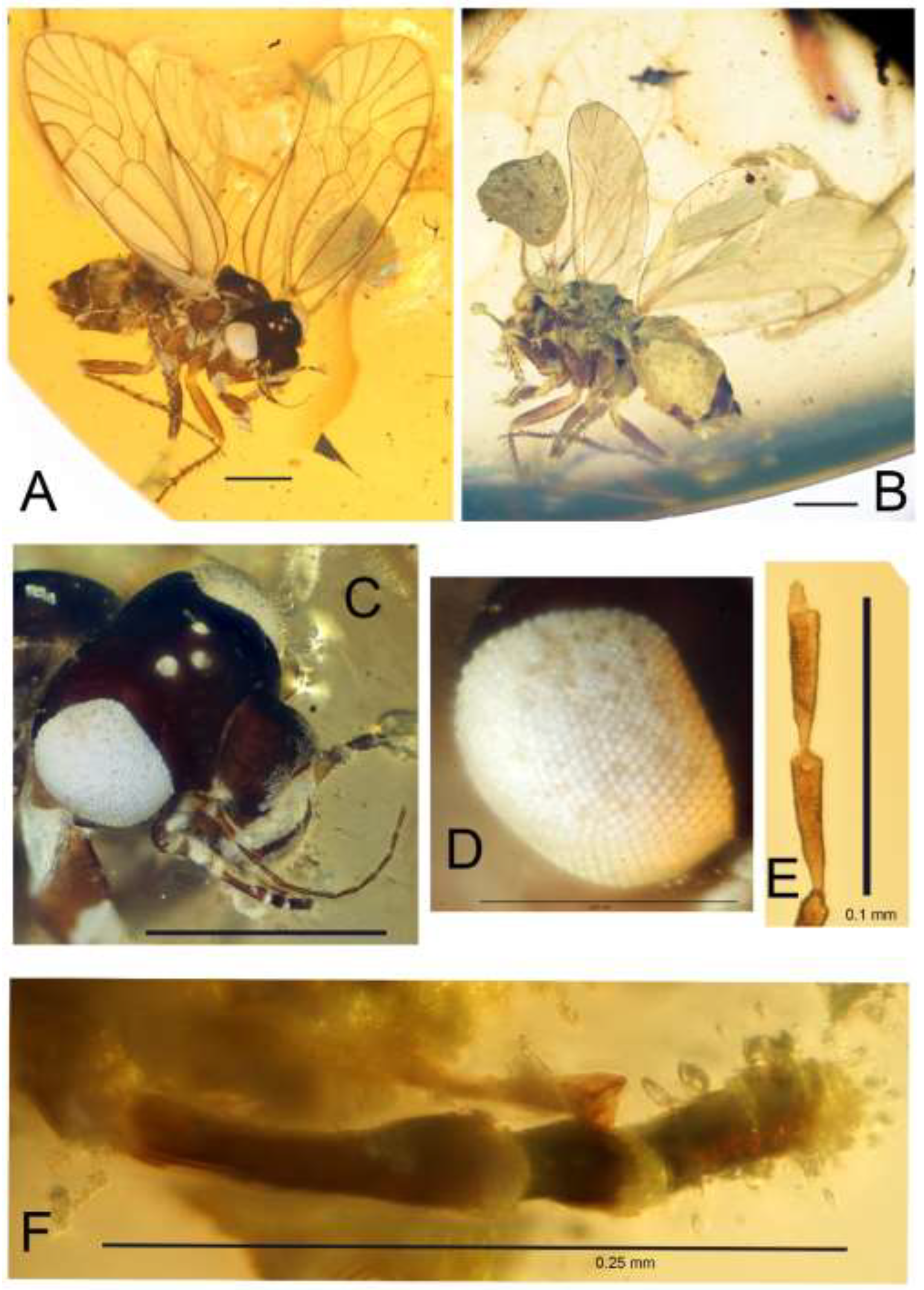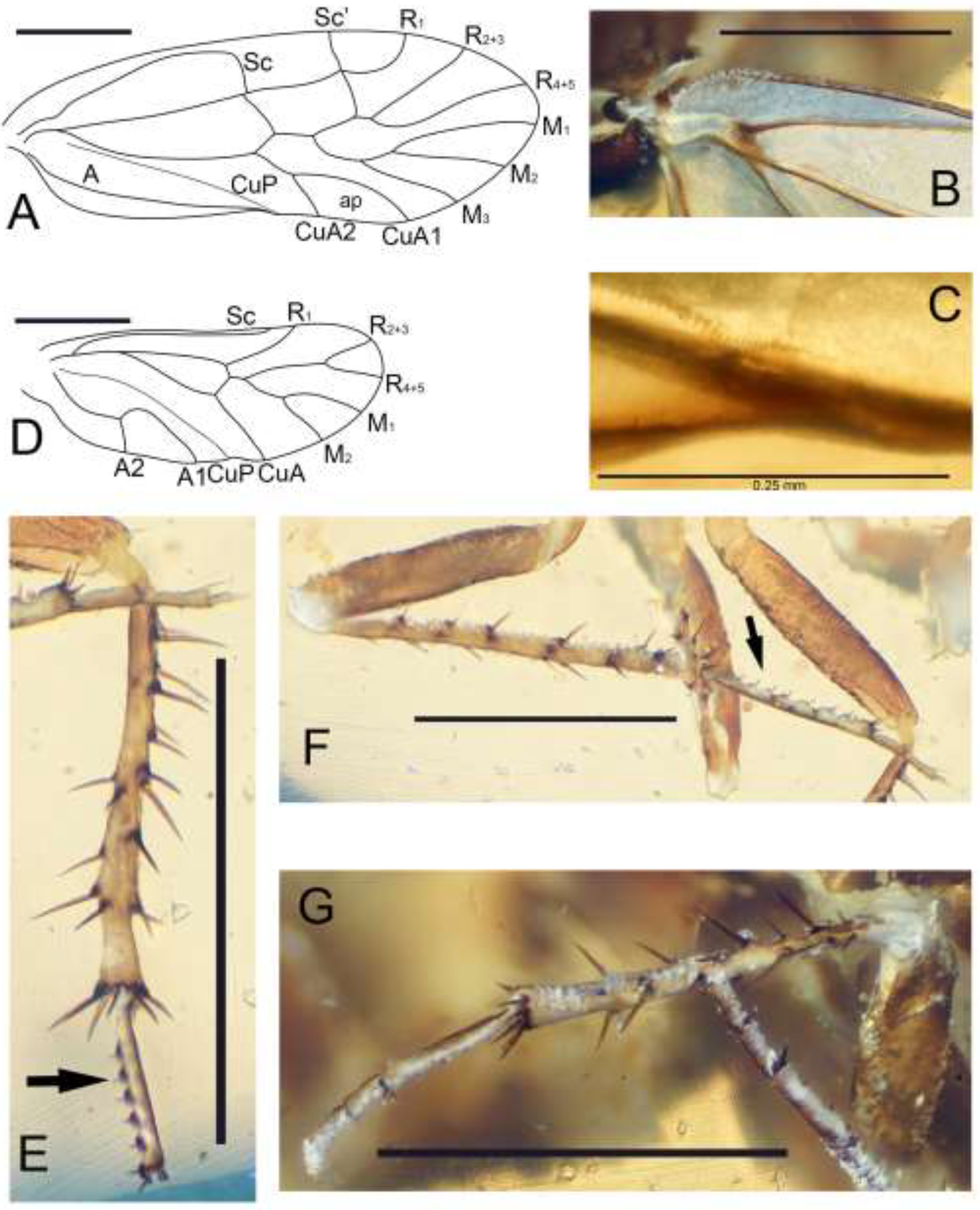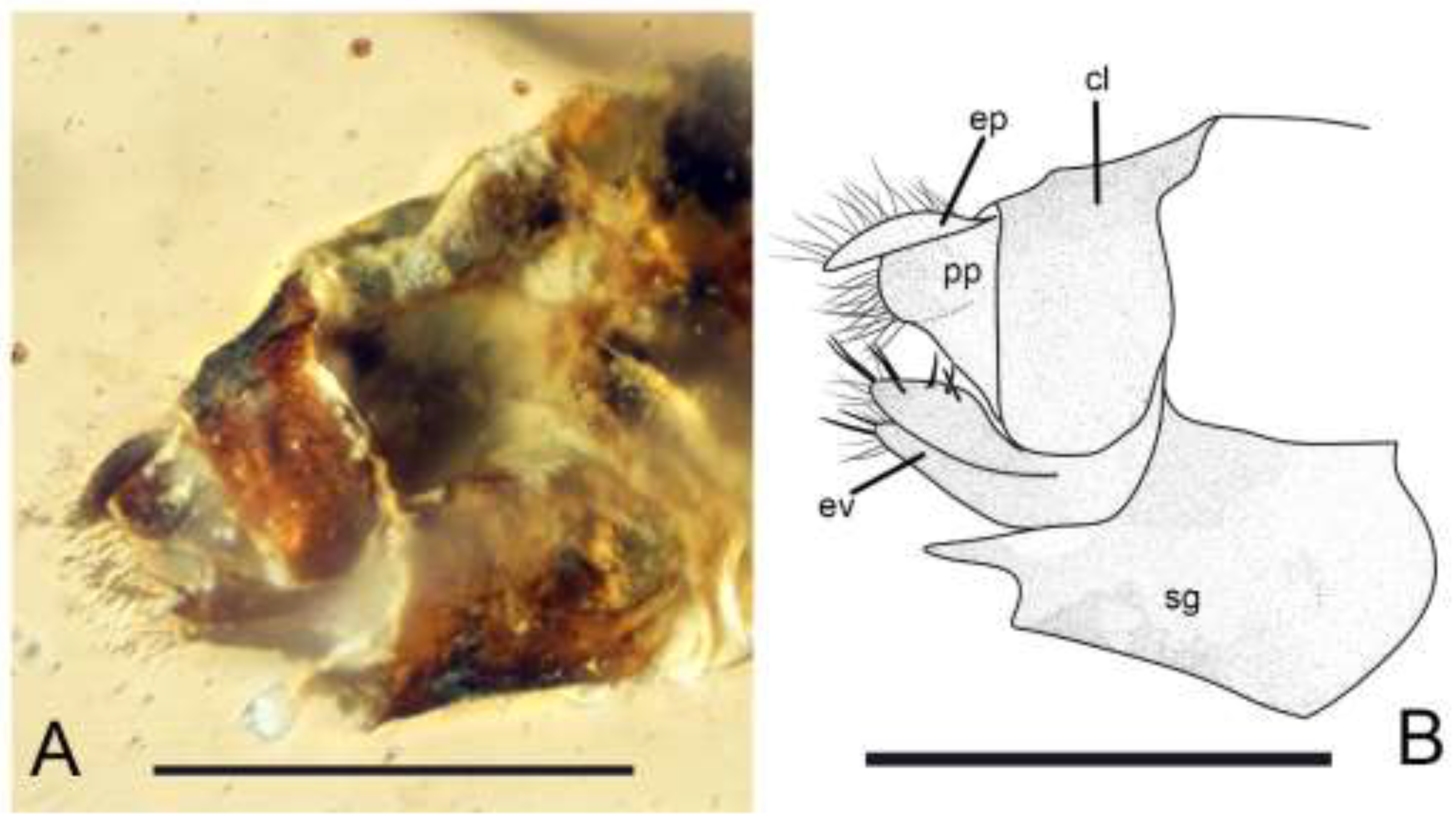A New Genus and Species of the Suborder Trogiomorpha (Insecta, Psocodea) from Mid-Cretaceous Amber of Myanmar †
Abstract
Simple Summary
Abstract
1. Introduction
2. Materials and Methods
3. Results
4. Discussion
Author Contributions
Funding
Data Availability Statement
Acknowledgments
Conflicts of Interest
References
- Yoshizawa, K.; Johnson, K.P. Phylogenetic position of Phthiraptera (Insecta: Paraneoptera) and elevated rate of evolution in mitochondrial 12S and 16S rDNA. Mol. Phylogenet. Evol. 2003, 29, 102–114. [Google Scholar] [CrossRef]
- Johnson, K.P.; Yoshizawa, K.; Smith, V.S. Multiple origins of parasitism in lice. Proc. R. Soc. Lond. Ser. B Biol. Sci. 2004, 271, 1771–1776. [Google Scholar] [CrossRef] [PubMed]
- Lienhard, C.; Smithers, C.N. Psocoptera (Insecta): World Catalogue and Bibliography; Instrument Biodiversitatis V.; Muséum d’histoire naturelle: Geneve, Switzerland, 2002; 745p. [Google Scholar]
- Yoshizawa, K. Phylogeny and higher classification of suborder Psocomorpha (Insecta: Psocodea: “Psocoptera”). Zool. J. Linn. Soc. 2002, 136, 371–400. [Google Scholar] [CrossRef]
- Yoshizawa, K.; Johnson, K.P. How stable is the “Polyphyly of Lice” hypothesis (Insecta: Psocodea)?: A comparison of phylogenetic signal in multiple genes. Mol. Phylogenet. Evol. 2010, 55, 939–951. [Google Scholar] [CrossRef] [PubMed]
- Johnson, K.P.; Dietrich, C.H.; Friedrich, F.; Beutel, R.G.; Wipfler, B.; Peters, R.S.; Allen, J.M.; Petersen, M.; Donath, A.; Walden, K.K.; et al. Phylogenomics and the evolution of hemipteroid insects. Proc. Natl. Acad. Sci. USA 2018, 115, 12775–12780. [Google Scholar] [CrossRef]
- Misof, B.; Liu, S.; Meusemann, K.; Peters, R.S.; Donath, A.; Mayer, C.; Frandsen, P.B.; Ware, J.; Flouri, T.; Beutel, R.G.; et al. Phylogenomics resolve the timing and pattern of insect evolution. Science 2014, 346, 763–767. [Google Scholar] [CrossRef]
- De Moya, R.S.; Yoshizawa, K.; Walden, K.K.O.; Sweet, A.D.; Dietrich, C.H.; Johnson, K.P. Phylogenomics of Parasitic and Nonparasitic Lice (Insecta: Psocodea): Combining Sequence Data and Exploring Compositional Bias Solutions in Next Generation Data Sets. Syst. Biol. 2021, 70, 719–738. [Google Scholar] [CrossRef]
- Mockford, E.L.; Lienhard, C.; Yoshizawa, K. Revised classification of ‘Psocoptera’ from Cretaceous amber, a reassessment of published information. New Ser. J. Fac. Agric. Hokkaido Univ. Ser. Entomol. 2013, 69, 1–26. [Google Scholar]
- Azar, D.; Huang, D.Y.; El-Hajj, L.; Cai, C.Y.; Nel, A.; Maksoud, S. New Prionoglarididae from Burmese amber (Psocodea: Trogiomorpha: Prionoglaridetae). Cretac. Res. 2017, 75, 146–156. [Google Scholar] [CrossRef]
- Wang, R.Q.; Li, S.; Ren, D.; Yao, Y.Z. New genus and species of Cormopsocidae (Psocodae: Trogiomorpha) from mid-Cretaceous amber of northern Myanmar. Cretac. Res. 2021, 128, 104992. [Google Scholar] [CrossRef]
- Yoshizawa, K.; Lienhard, C. Cormopsocidae: A new family of the suborder Trogiomorpha (Insecta: Psocodea) from Burmese amber. Entomol. Sci. 2020, 23, 208215. [Google Scholar] [CrossRef]
- Liang, F.Y.; Liu, X.Y. A new genus and species of the family Cormopsocidae (Psocodea: Trogiomorpha) from mid-Cretaceous amber of Myanmar. Cretac. Res. 2022, 130, 15049. [Google Scholar] [CrossRef]
- Lienhard, C. Description of a new African genus and a new tribe of Speleketorinae (Psocodea: ’Psocoptera’: Prionoglarididae). Rev. Suisse Zool. 2007, 114, 441–469. [Google Scholar] [CrossRef]
- Hakim, M.; Azar, D.; Fu, Y.Z.; Cai, C.Y.; Huang, D.Y. A new cormopsocid from mid-Cretaceous Burmese amber (Psocodea: Trogiomorpha: Cormopsocidae). Palaeoentomology 2021, 4, 178–185. [Google Scholar] [CrossRef]
- Hakim, M.; Azar, D.; Huang, D.Y. A new species of Cormopsocidae from Burmese amber (Psocodea; Trogiomorpha). Palaeoentomology 2021, 4, 213–217. [Google Scholar] [CrossRef]
- Cumming, R.T.; Le Tirant, S. Review of the Cretaceous Archaeatropidae and Empheriidae and description of a new genus and species from Burmese amber (Psocoptera). Faunitaxys 2021, 9, 1–11. [Google Scholar]
- Mao, Y.Y.; Liang, K.; Su, Y.T.; Li, J.G.; Rao, X.; Zhang, H.; Xia, F.Y.; Fu, Y.Z.; Cai, C.Y.; Huang, D.Y. Various amber ground marine animals on Burmese amber with discussions on its age. Palaeoentomology 2018, 1, 91–103. [Google Scholar] [CrossRef]
- Shi, G.; Grimaldi, D.A.; Harlow, G.E.; Wang, J.; Wang, J.; Wang, M.; Lei, W.; Li, Q.; Li, X. Age constraint on Burmese amber based on U-Pb dating of zircons. Cretac. Res. 2012, 37, 155–163. [Google Scholar] [CrossRef]
- Yoshizawa, K. Morphology of Psocomorpha (Psocodea: ‘Psocoptera’). New Ser. J. Fac. Agric. Hokkaido Univ. Ser. Entomol. 2005, 62, 1–44. [Google Scholar]
- Yoshizawa, K.; Lienhard, C.; Johnson, K.P. Molecular systematics of the suborder Trogiomorpha (Insecta: Psocodea: “Psocoptera”). Zool. J. Linn. Soc. 2006, 146, 287–299. [Google Scholar] [CrossRef]
- Yoshizawa, K.; Johnson, K.P.; Sweet, A.D.; Yao, I.; Ferreira, R.L.; Cameron, S.L. Mitochondrial phylogenomics and genome rearrangements in the barklice (Insecta: Psocodea). Mol. Phylogenet. Evol. 2018, 119, 118–127. [Google Scholar] [CrossRef] [PubMed]
- Smithers, C.N. The classification and phylogeny of the Psocoptera. Aust. Mus. Mem. 1972, 14, 1–349. [Google Scholar] [CrossRef]
- Hakim, M.; Azar, D.; Huang, D.Y. A unique manicapsocid (Psocodea: Amphientometae) from the mid-Cretaceous Burmese amber. Cretac. Res. 2020, 107, 104278. [Google Scholar] [CrossRef]



Publisher’s Note: MDPI stays neutral with regard to jurisdictional claims in published maps and institutional affiliations. |
© 2022 by the authors. Licensee MDPI, Basel, Switzerland. This article is an open access article distributed under the terms and conditions of the Creative Commons Attribution (CC BY) license (https://creativecommons.org/licenses/by/4.0/).
Share and Cite
Zhang, X.; Liang, F.; Liu, X. A New Genus and Species of the Suborder Trogiomorpha (Insecta, Psocodea) from Mid-Cretaceous Amber of Myanmar. Insects 2022, 13, 1064. https://doi.org/10.3390/insects13111064
Zhang X, Liang F, Liu X. A New Genus and Species of the Suborder Trogiomorpha (Insecta, Psocodea) from Mid-Cretaceous Amber of Myanmar. Insects. 2022; 13(11):1064. https://doi.org/10.3390/insects13111064
Chicago/Turabian StyleZhang, Xinyi, Feiyang Liang, and Xingyue Liu. 2022. "A New Genus and Species of the Suborder Trogiomorpha (Insecta, Psocodea) from Mid-Cretaceous Amber of Myanmar" Insects 13, no. 11: 1064. https://doi.org/10.3390/insects13111064
APA StyleZhang, X., Liang, F., & Liu, X. (2022). A New Genus and Species of the Suborder Trogiomorpha (Insecta, Psocodea) from Mid-Cretaceous Amber of Myanmar. Insects, 13(11), 1064. https://doi.org/10.3390/insects13111064






